Designing the perfect barn involves more than just functional considerations—it is an opportunity to pay homage to what horses have meant to our ancestors for centuries.
Modern stable design trends this year have a strong focus on marrying aesthetics, sustainability, and engineering – all concepts that offer exciting possibilities for equestrians to create a space that’s safe, environmentally friendly, aesthetically pleasing, and in step with modern design and engineering.
By incorporating one or more of these trends into your barn design, you too can create a space that caters to both functional needs and stylistic aspirations as well as being optimized for the well-being and comfort of your horses.
Modern Rustic Aesthetic
At its core, modern rustic architecture fuses the weathered charm of the old with the sleek sophistication of the new. This architectural style captures a sense of timelessness while embracing modernity, resulting in a look that’s both historic and contemporary.
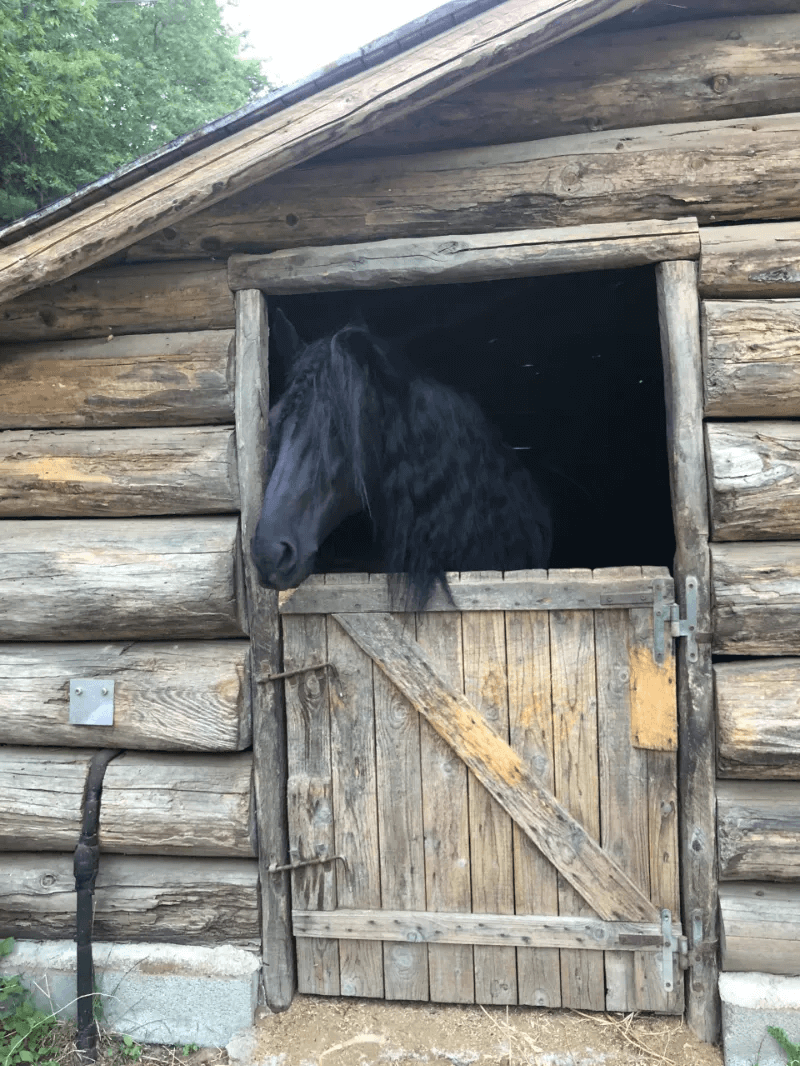
Rustic elements serve as the cornerstone of this barn style – sturdy beams, reclaimed wood, and original stone foundations blend with modern fixtures and minimalistic finishes to create spaces that are both familiar and fresh, beautifully embodying the past, the present, and the future of barn architecture.
Ultimately, the modern rustic aesthetic in barn architecture is more than just a design style. It’s a thoughtful exploration of balance, a testament to the harmony between heritage barn architecture and the innovative spirit of modern architecture.
Custom wooden stable doors embody the spirit of modern rustic barn architecture, effectively marrying function with elegance. These doors pay homage to the rustic charm of traditional barns, their wood grains and natural colorations reminiscent of the countryside’s inherent simplicity.
Contemporary Industrial
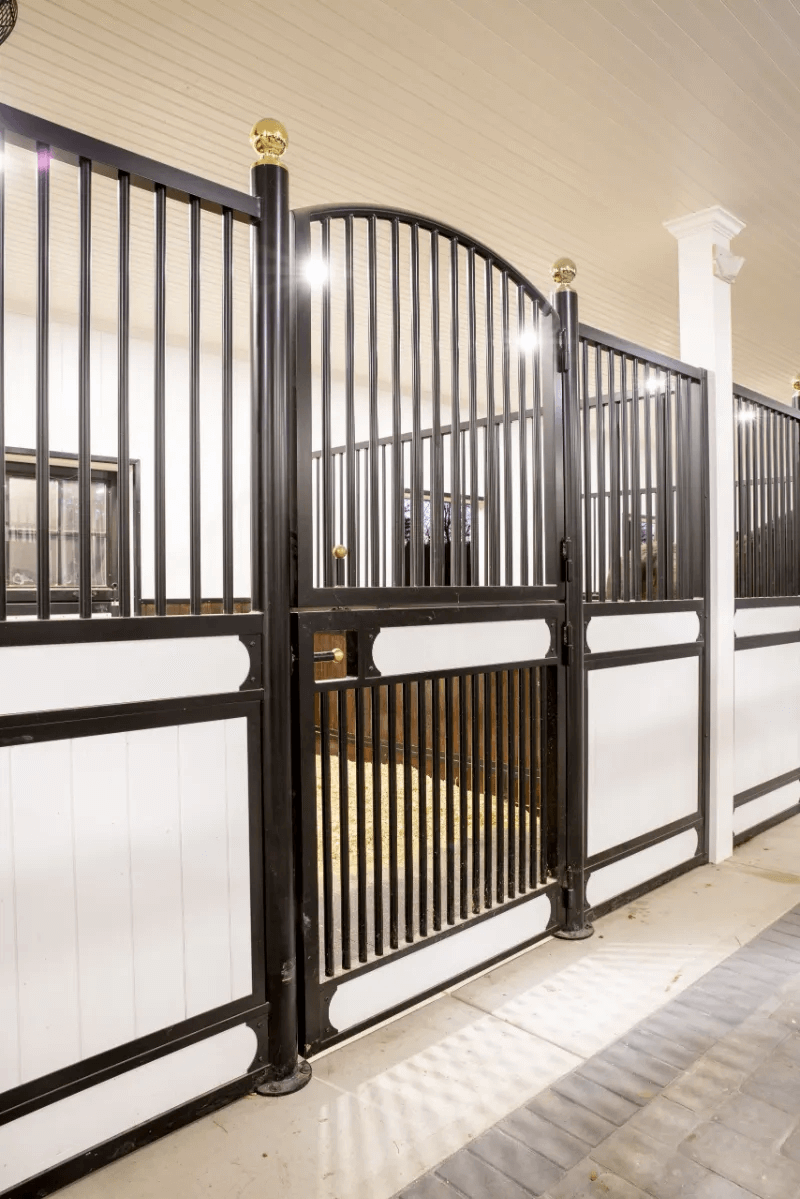
Contemporary Industrial is another popular architectural design trend this year for barns. This style celebrates the raw, unfinished aesthetics of industrial elements, adding a unique and edgy touch to equestrian properties. Materials such as raw steel, frosted glass, and brushed nickel are prominent in this trend.
The carriage door, steeped in equestrian tradition, is experiencing a renaissance in 2023 as barn designers embrace their blend of rustic charm and functional elegance.
Their swing-out design minimizes obstructions within the barn and allows for a larger opening than typical sliding doors, which offers a more inviting and open feel, establishing a space that’s as welcoming as it is functional.
The style aligns well with the overarching trend of blending industrial and contemporary design principles in barn architecture. They bring with them an old-world charm, conjuring up a sense of nostalgia and timelessness while accommodating the demands of modern-day horse care and barn usage.
Eco-Friendly Materials
In 2023, the focus on sustainability in barn design is more prominent than ever, with an increasing number of designers harnessing eco-friendly materials for barn doors.
Recycled wood, bamboo, and other sustainable materials are rapidly becoming preferred options in an industry that has long been conscious of the environment and aesthetics.
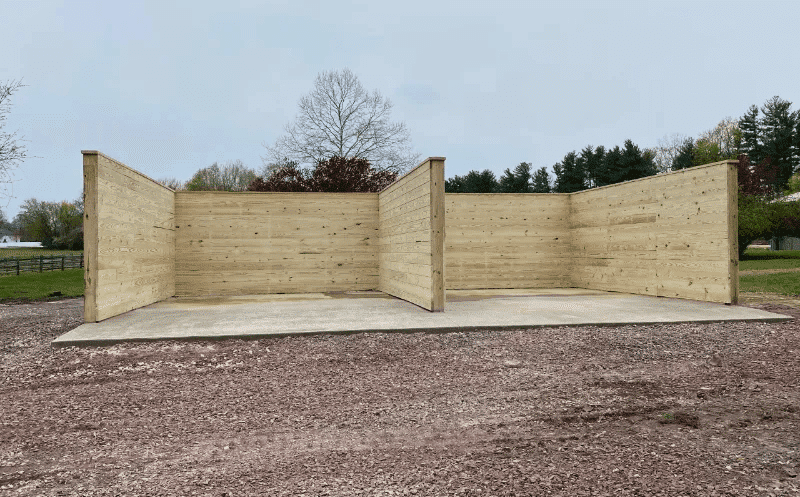
Among these sustainable materials, Southern Yellow Pine, milled for tongue and groove lumber, has emerged as a popular choice for finishing the interiors of horse barns. Grown predominantly in managed forests in the Southern United States, this particular type of wood offers an excellent balance of strength, durability, and sustainability and is known for its versatility and adaptability, capable of serving various roles in barn architecture, especially when it comes to door construction.
The Southern Yellow Pine used in our barn projects is milled in Lancaster, PA, with ease-of-use for builders at the forefront of the milling process. This focus ensures seamless integration when constructing or refurbishing stables, eliminating the struggle traditionally associated with joining tongue and groove lumber. Even better, this attractive wood comes in various lengths and can be naturally treated or pressure treated for ground contact, enhancing its resilience against the elements.
Features which encourage social interaction
The concept of designing barns to align with the natural way in which horses behave, has been integrated more and more into building design over the past decade, with the use of natural materials, colors, and welfare-friendly elements to create an environment that enhances well-being for both stalled horses.
The architectural trend of horse-friendly stall design highlights a shift towards more socially engaging environments for horses. An exemplar of this trend is the use of European stall fronts, also known as hinged horse stalls or “Euros”.
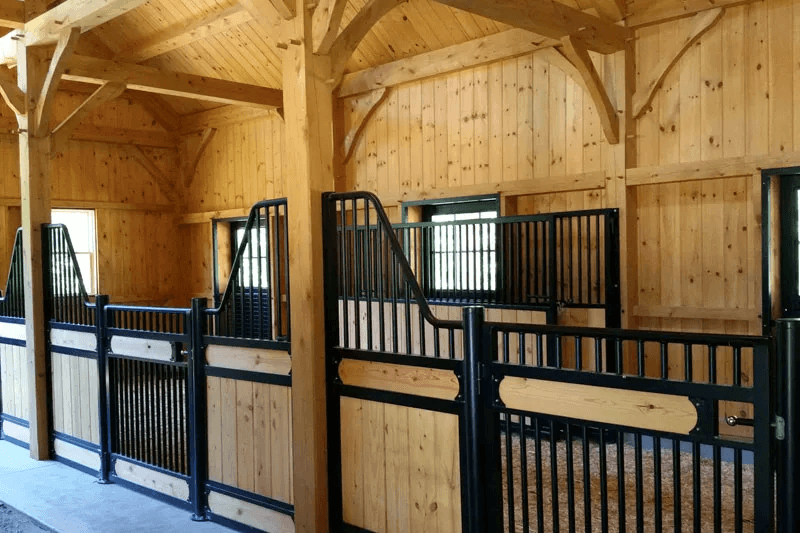
These stalls are designed with the intent of maximizing socialization amongst horses, considering their naturally herd-oriented behavior. The distinctive features of the European stall fronts include the door and sides (or wings) that manifest in a sweeping curve. This curvature doesn’t just foster interaction but also lends an elegant and natural aesthetic to a barn.
These European stall fronts are robustly constructed from heavy-gauge steel and aluminum, ensuring durability and longevity. However, strength doesn’t come at the expense of style.
The fronts can be fabricated in a wide array of colors and styles, catering to varying tastes and barn themes. This ability to customize showcases a perfect amalgamation of functionality and aesthetics, a central tenet of modern architectural trends.
Further enhancing their utility, European stalls can be tailored to incorporate an offset or center opening, and single or double swinging door options. This flexibility allows the stalls to meet specific horse needs and various barn design requirements.
The incorporation of European stall fronts is reflective of the broader trend towards horse-friendly design, where the welfare and happiness of horses is given top priority. By blending this care with versatile design choices, these stalls underscore a contemporary approach to barn architecture that respects both equine needs and human aesthetics.
Better Air Flow
Proper ventilation is crucial in a barn environment to maintain the health and well-being of the horses. Horses produce a considerable amount of moisture through respiration and perspiration, and when mixed with ammonia from urine, it can create a harmful environment if not properly ventilated. The stale air, dust, mold spores, and bacteria that can accumulate in a poorly ventilated barn are potential triggers for respiratory problems in horses.
Dutch doors, with their distinctive design of a split between the top and bottom halves, offer significant advantages in terms of airflow and the health of horses when implemented in barn design. The ability to open only the top half allows for increased ventilation without compromising the safety of the horses and the design of these doors also means horses can see and interact with their environment while still being safely contained, which can contribute positively to their overall mental well-being.
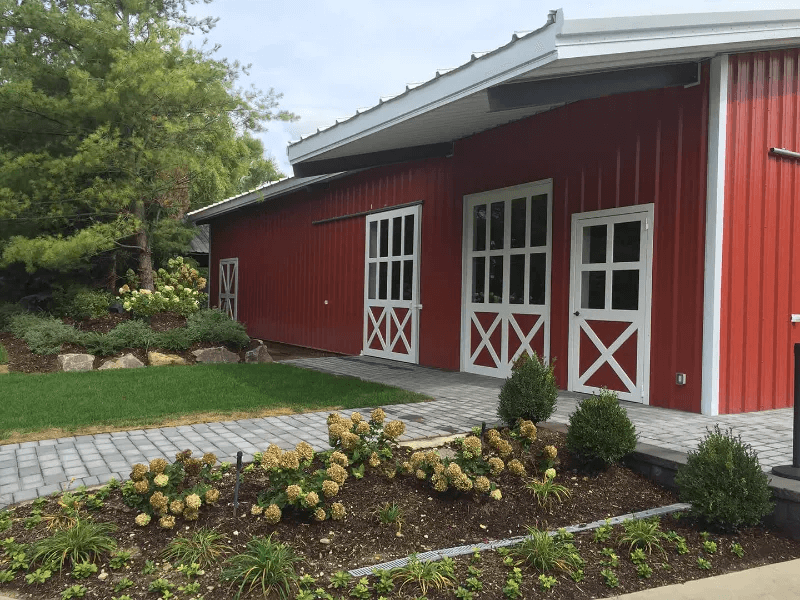
The door’s inherent ruggedness, often constructed from reclaimed wood or distressed metal, not only provides a visually appealing style, but also contributes to a healthier environment for horses by ensuring good ventilation, sunlight infiltration, and opportunities for social engagement.
Better Barn Fixtures
Premium hardware for barns is no longer a design preference, it has become a necessity.
Since todays barns are exposed to diverse weather elements, selecting robust exterior barn door hardware is of paramount importance for longevity, functionality, and most importantly, safety.
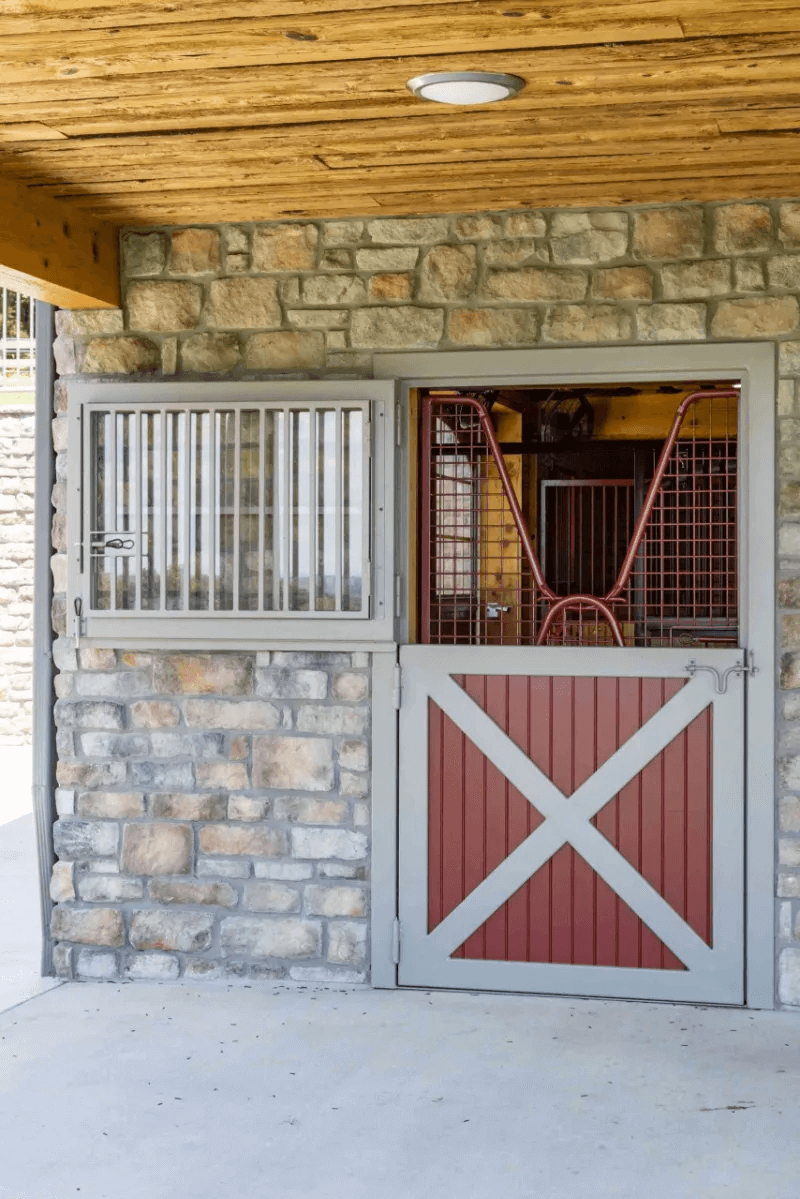
The recent surge in extreme climatic events, accentuated by climate change, means barns face unpredictable and severe weather patterns. Winters can be harsh, causing doors and other materials to contract and potentially shrink.
This can lead to a loosening of standard hardware, risking the unintended escape of horses – jeopardizing their safety, as well as the efficient operation of the barn. Such contingencies underline the importance of not just choosing, but investing in, meticulously crafted premium hardware.
Premium products are not just designed to endure severe conditions, but are engineered with an extra layer of security against unexpected climatic threats and include lock systems, hinges, runners, and handles – all built with an emphasis on durability, strength, and superior functionality over mass-produced low priced alternatives.
In an era of climate change, investing in high-quality design or even just barn hardware is not merely about aesthetics or endurance, but fundamentally about ensuring resilience and peace of mind. It’s an assurance that your barn can withstand the elements, offer robust security, and keep your horses safe and secure, irrespective of the season or the severity of climatic events.
These 2023 Barn Trends are exemplary of a broader shift in barn architecture: a drive to create spaces that are not only functional and sturdy, but that also prioritize the safety and well-being of the animals they shelter above all else.